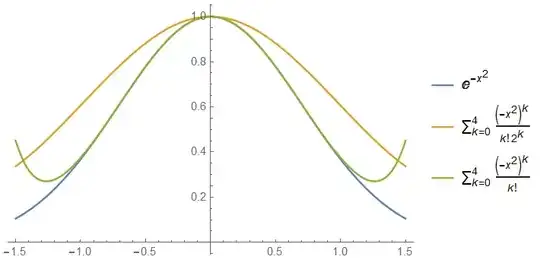I was interested in one of the topics on this website, while I noticed a notation that I haven't been able to understand. This is the original question. One of the answers to the question states that $$ e^{-x^2}=1-(1/2)x^2+(1/2)(1/4)x^4-(1/6)(1/8)x^6+(1/24)(1/16)x^8+\cdots $$ I don't see how my answer would be different from his. Mine involved simply substituting $-x^{2}$ instead of the $x$ in the regular $e^{x}$'s expansion, yielding : $$ e^{-x^2}=1-x^2+(1/2)x^4-(1/6)x^6+(1/24)x^8+\cdots $$ Thanks for taking the time to read it through.
PS : I would have liked simply commenting on the answer to ask the original writer, but I apparently need a certain amount of "reputation" to do that.
